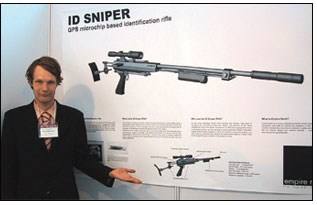“Sniper Rifle May Aim RFID Tags At Human Targets,” screamed the ominous headline of an April 28 article on the Australian Web site of Computerworld, a trade publication. “If the thought of a government secretly inserting miniature tracking chips into persons deemed enemies of the state harks of an Orwellian conspiracy theory, a Danish company is doing its level best to bring this type of technology into the hands of authorities,” the story read.
The article indicated that Empire North, a Copenhagen-based firm, “is currently demonstrating a modified sniper rifle as a means to inject unsuspecting targets with an RFID tag in order to track their movements.” It quoted an unnamed source at the University of Sydney’s department of physics who said the concept was “not impossible if the materials used were sufficiently lightweight and the velocity of the projectile calculated in conjunction with the range.”
Sounds like a case of truth being stranger than fiction. Turns out the story was based on a two-year-old hoax perpetrated by Jakob S. Boeskov, a Danish pop conceptual artist working with other Danish artists on an avant-garde magazine called Black Box.
“Our editor, Mads Brügger, suggested that we create a fake Danish weapon and infiltrate a weapons fair in Beijing,” says Boeskov. “We wanted to create the most horrible weapon we could think of, one that reflected the repressive nature of the Chinese regime. I met an industrial designer, Kristian Von Bengtson, and we came up with this idea of an ID gun.”
Boeskov created marketing materials and a bogus Web site for Empire North, his fictional manufacturer of the ID gun. The marketing material actually said the gun used a Global Positioning System microchip, not RFID. GPS requires a battery and transmitter, so the idea that such a device could be shot into a human without the person knowing it was silly. (A passive RFID tag with a tiny antenna might have been a better choice, but even if that were feasible, its read range would have been limited to a few inches or less.) But when Boeskov took the concept to China Police 2002, China’s first international weapons fair, arms dealers at the event embraced it.
“People loved it,” Boeskov says. “A Brazilian arms dealer told me that people are always escaping from their jungle prisons and this would help them track down prisoners. A Chinese company wanted to help me find venture capital and a place to manufacture the gun. It was scary.”
In April of this year, Boeskov presented the project at The Thing, a New York art gallery. “Rumors started that I was there to sell the gun to the New York Police Department,” he says. “I got several e-mails from weapons dealers from Israel, Russia and the United States, as well as U.S. generals, all interested in buying the weapon.”
Around the same time, someone discovered the Empire North Web site and posted a message about the gun on Slashdot, a popular site that offers what it calls “news for nerds.” That drove 1.6 million people—including, apparently, the Computerworld writer—to the Empire North site.
Soon after the article ran, several people posted messages on RFID bulletin boards to expose the hoax. But the fact that a reputable magazine and so many people thought the gun was real shows how little people understand about RFID—and how much work the RFID industry will need to do to reassure consumers about the technology and the threat it could pose to their privacy.


